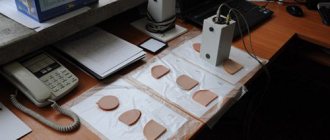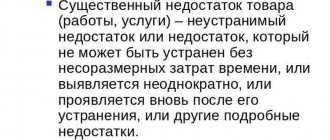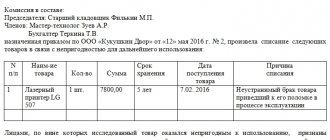What is “adequate” and “inadequate” quality of a product?
The quality of a product is a set of consumer properties of a product that meets the reasonable and sufficient needs of the buyer, and excludes harm to the buyer and the environment during its proper operation, storage, transportation and consumption.
From a legal point of view, the quality of a product can be: proper or improper.
The legislation does not provide direct definitions of the concepts of “adequate quality” and “inadequate quality”.
Proper quality of a product is a state of the product when all mandatory requirements for the product provided for by law or contract are met (or are being met), and as a result, the product can be used for its intended purpose, and therefore be useful to the consumer. In addition, such quality simultaneously implies that the product is safe and has no defects.
Requirements for the quality of goods are enshrined in Art. 469 of the Civil Code of the Russian Federation:
- The seller is obliged to transfer to the buyer the goods, the quality of which corresponds to the purchase and sale agreement.
- If there are no conditions in the sales contract regarding the quality of the goods, the seller is obliged to transfer to the buyer goods suitable for the purposes for which goods of this kind are usually used.
If the seller, at the conclusion of the contract, was informed by the buyer about the specific purposes of purchasing the goods, the seller is obliged to transfer to the buyer the goods suitable for use in accordance with these purposes.
- When selling goods based on a sample and (or) description, the seller is obliged to transfer to the buyer the goods that correspond to the sample and (or) description.
- If the law or the procedure established by it provides for mandatory requirements for the quality of the goods being sold, then the seller carrying out entrepreneurial activities is obliged to transfer to the buyer goods that meet these mandatory requirements.
What is “inadequate quality” of a product?
Inadequate quality of the product means that the above requirements are not fully met or only partially met.
Inadequate quality of goods (latent defect definition) is the non-compliance of goods with either mandatory requirements provided for by law, or the terms of the contract, or the purposes for which goods of this kind are usually used, or the purposes of which the seller was informed by the consumer when concluding the contract, or sample (description) when selling goods according to the sample and (or) description.
When speaking about the “inadequate” quality of a product, the Civil Code of the Russian Federation and the Law on the Protection of Consumer Rights provide only the formulation of the concepts of “defect” and “significant defect”.
A common defect is the non-compliance of the goods either with the mandatory requirements provided for by law or in the manner prescribed by it, or with the terms of the contract (in their absence or incompleteness of the conditions usually presented to the requirements), or with the purposes for which goods of this kind are usually used, or with the purposes of which the seller was aware informed by the consumer when concluding a contract, or a sample and (or) description when selling goods according to the sample and (or) description;
Significant defect - an obvious defect is an irreparable defect or defect that cannot be eliminated without disproportionate costs or time, or is detected repeatedly, or appears again after its elimination, or other similar defects.
This is also important to know:
Resolution No. 55: list of goods that cannot be returned or exchanged when the list is not valid
In the first case, we are talking about a common defect in which the product can still be used for its intended purpose. For example, this type of defect may include a malfunction of the heated rear window in a new car.
From the meaning of defining a significant defect in a product, it is clear that with such a defect the product cannot be used for its intended purpose, for example, if the door of a new washing machine cannot be closed.
Thus, a product of “inadequate quality” is a product that has a “defect” or “significant defect”.
In practice, there are common cases when a defect in a product appears only after some time of use or is not noticeable upon receipt of the product. Thus, another classification of product defects is of no small importance.
Classification of product defects
A defect is any flaw or non-compliance of an item with the provisions of Russian legislation and the terms of the contract concluded with the seller.
In this case, the defective product cannot be used for its intended purpose, because it does not have one or more necessary characteristics, the presence of which is established by the documentation or discussed between the seller and the buyer.
There are two main types of shortcomings:
- obvious defects are easily identifiable defects;
- hidden defects are significant deviations.
The first ones are easily determined by a thorough inspection and checking the functionality of the item directly in the store.
According to Article 475 of the Civil Code of the Russian Federation, hidden defects in a product are grounds for returning the item of purchase back to the store. It is much more difficult to detect them; in practice, it is necessary to conduct an appropriate examination and obtain the opinion of a specialist.
In accordance with the legislation of the Russian Federation, which is also in force in 2019, hidden product defects are significant deviations from the following indicators:
- Legislative standards that exist in the country.
- The terms of the completed agreement for the sale and purchase of goods.
- The intended purpose or main objectives that were voiced by the seller to the buyer.
Depending on the degree of significance, the following defects are distinguished:
- Critical defects are non-compliance of goods with the requirements that have been established. They can cause harm to life, health, property of consumers or the environment. Products with such defects cannot and should not be used for their intended purpose.
- Significant nonconformity defects have a significant impact on the intended use and reliability of the products. But they do not affect the safety of consumers and the environment.
- Minor defects do not significantly affect the consumer properties of goods, primarily their purpose, reliability and safety.
The above types of defects are taken into account when choosing the type of product quality control. To identify a critical defect, continuous monitoring is necessary, and in some cases repeated. Control of other defects can be carried out selectively.
In accordance with legal norms, hidden defects can be called defects in the product, the absence of functionality declared or voiced by the seller, but the intended functionality, or other discrepancies between the product and the description or image.
In the Civil Code of the Russian Federation, the term significant defect is used for repair work that cannot be eliminated at all or due to the financial unprofitability of carrying out repair work.
Free legal consultation We will answer your question in 5 minutes!
Ask a Question
Free legal consultation
We will answer your question in 5 minutes!
Ask a Question
A hidden defect in a product may not be noticeable during testing at the time of purchase, but it will become apparent upon further use. If the seller is aware of this, he is obliged to provide the buyer with complete information about hidden and obvious defects of the product.
The peculiarity of a hidden defect is that it occurs after the buyer receives the goods; the cause of its occurrence must be determined by an examination. In turn, the buyer is obliged to prove that it was not his fault.
A positive outcome for the consumer will only be if he fully complied with the operating rules, and the breakdown occurred as a result of a manufacturing defect or the negligence of the carrier.
This examination is paid for by the seller, and the buyer has the right to monitor the entire process of its implementation.
But if experts conclude that the buyer caused the defect, then he will have to reimburse all costs.
According to the level of significance, flaws are also divided into minor, critical and significant. In the first case, we are talking about inconsistencies that do not have a big impact on the basic characteristics of the thing (for example, when buying bread that is not too brown).
This is also important to know:
Compensation for moral damage, compensation procedure
In the case of critical defects, the use of the item is impractical and even unsafe for the consumer. Significant defects may prevent the purchased item from being used for its intended purpose, but do not pose a danger to human life and health.
If a defect can be corrected, it is considered repairable. If a low-quality product cannot be repaired or requires large financial costs, the defects are considered irreparable.
Types of defects
You can return both quality and defective goods within 14 days from the date of purchase, counting the day of purchase, or during the warranty period, if applicable.
Defects are products manufactured in violation of standards and specifications or with deviations from them, which do not meet the quality requirements for products or the requirements specified in the contract when making a purchase.
There are different types of defects that can be divided into several groups.
By means of detection there are:
- Obvious defects. They can be detected visually and no special monitoring equipment is required.
- Hidden or internal defects. Upon external inspection, such defects are difficult to notice; they are discovered during operation or during storage of the goods.
Depending on the possibility of correction and the availability of methods for this, defects are distinguished:
- Removable. Correction is possible and economically feasible.
- Unremovable. Correction is technically impossible and economically infeasible.
Helpful information
The Civil Code of the Russian Federation in paragraph 2 of Article 475 defines the concept of a significant defect in a product - this is such a breakdown of a technically complex product, as a result of which it is impossible to use it for its intended purpose. On our website in this article we will consider the conditions under which a deficiency can be considered significant.
Depending on the location of occurrence, defects are:
- Production. Appeared at the production stage due to technology errors, low-quality materials, etc.
- Pre-sales. Arose at the stage of storage and transportation.
- Operational. Appeared at the operational stage.
According to the degree of significance, defects are distinguished:
- Critical. The product cannot be used for its intended purpose.
- Significant. Inconsistencies prevent the item from being used for its intended purpose, but they do not affect the safety of the consumer or the environment.
- Minor defects. They do not have a serious impact on the consumer properties of the product, the ability to use it for its intended purpose, reliability, or safety.
Before returning the product to the store, evaluate what type of defect your purchase has and whether it was caused by your incorrect actions.
According to the law, having discovered a defect due to which the use of an item becomes impossible, the buyer has the right to return it to the store, except in cases where:
- The breakdown or malfunction was caused by the buyer.
- The presence of a flaw was specified at the time of purchase, for example, a TV with a scratch on the body was sold cheaper, and the buyer knew this.
- The warranty period has expired, entitling you to free repair or replacement.
If the identified defects are irreparable, such goods are considered defective.
When purchasing, you need to carefully inspect the item to notice any obvious flaws. Otherwise, in the future you will have to prove your non-involvement in their occurrence, and the return of money for defective goods may take a long time.
Defective product: the law is on the consumer’s side
The corresponding Law (Article 18), as well as Article 475 of the Civil Code of the Russian Federation, is intended to protect the rights of citizens when purchasing goods of inadequate quality. These legislative documents reflect the possibility of protecting and restoring consumer rights through:
- contacting the point of sale, where you can make demands for a replacement product (similar, similar) and a proportionate reduction in the purchase price;
- organizing free elimination of deficiencies (at the expense of the seller, manufacturer), processing compensation for finances spent on repairs carried out at the expense of the buyer;
- refusal to purchase with reimbursement of all expenses or a proportional part.
The Civil Code clearly states the provisions on the basis of which hidden defects in a product are a legal basis for its return to the seller.
Why defects are hidden
This is due to the generally accepted practice of inspecting the car by insurance experts.
Such a specialist has the right to inspect the car, guided only by the data from the accident certificate, which was issued by the traffic police inspector. If it only lists a cracked bumper, the expert may not want to check the condition of the body underneath. It is important to correctly understand what a hidden defect is. This is damage that can only be detected by performing additional diagnostic steps. Wiping off dirt from the fender to see a scratch is not an additional action, but removing a damaged bumper to check the condition of the body, partially disassembling a unit or assembly, or dismantling it for testing already fall under this category.
At the scene of the accident, the traffic police inspector will not take “additional actions.” He draws up documents, recording:
- circumstances of the incident;
- damage to all vehicles involved in the accident;
- their relative position, the presence of impact marks;
- other data.
When issuing a certificate, the inspector can assess the condition of the cars only superficially - he is not obliged to open the jammed hood and check the condition of the units underneath. Until 2012, the inspector could add the note “Possible hidden defects” to the certificate. Many car owners believe that this mark automatically entitles them to greater compensation. This is not true - even if damage is possible, this does not mean that it actually occurred. The car owner will have a much better chance of receiving compensation if he makes sure that the certificate describes all external damage and that the information in it is accurate and correct.
It is the job of an expert to detect hidden defects. They should be identified by an insurance company employee during an examination, but this is not in his interests. Therefore, most often the car is sent for repair only due to damage to the body, and then the following options are possible:
- The service station turns out to be conscientious and identifies additional defects. In the best case, the car owner is offered to notify the insurance company about this, complete the paperwork and have the car repaired entirely at the expense of compulsory motor liability insurance. At worst, you have to pay extra for repairs;
- The service station does not carry out any diagnostics, performs only work approved by insurance and delivers the car “as is” - with a faulty suspension or damaged units under the hood. When malfunctions become obvious, the car owner will deal with them independently.
What to do when buying something with a defect?
Based on Article 19 of the Law on the Protection of Consumer Rights, if the purchase turns out to be unfit for use , the buyer has the right to contact the store before the expiration date or service life of the product, as well as during the warranty period.
If the warranty period is not specified either by law or by the seller, the rights to legal repair, exchange and return remain with the buyer for two years .
As a rule, the service life begins from the moment the transaction is completed. However, in the case of seasonal goods , delivery of purchases by mail, or the need to install or configure the goods at the expense of the seller, the countdown of time begins from the beginning of the relevant season , receipt by the consumer of the purchase or performance of the relevant work (service), respectively.
The seller is obliged to independently deliver large goods for repair or to a warehouse when processing the return of products.
If the client takes on the hassle of delivering household appliances, furniture or a faulty vehicle, must compensate .
The seller or manufacturer, in turn, has the right to conduct an examination and identify the reasons for the lack of goods.
This right is often used when selling expensive products : luxury and premium clothing and shoes, furniture, household appliances, and electronics. The buyer is entitled to compensation only if the failure was actually the result of an internal defect.
The seller is not obliged to eliminate defects in the product, replace it or issue a refund in cases where the consumer or third parties have violated the principles and rules of transportation, storage and use of the product, as well as in cases of natural disasters or other uncontrollable circumstances.
In this case, the client will have to compensate the seller for the research costs. It is worth noting that the examination cannot take more than 45 days, therefore, if the deadline is violated, the buyer has the right to terminate the contract and return the funds spent.
If for one reason or another the seller refuses to eliminate the defects or replace the goods, as well as to return the money spent and compensate for damages, the consumer has the right to initiate legal proceedings and achieve justice in this way.
We tell you here how the defect in a product is eliminated and how to get it from the seller or service provider.
Detection of hidden defects
In most cases, defects are visible to the naked eye, so they are not difficult for an attentive buyer to detect. Have you been planning to buy cosmetics or food products, but noticed that they are approaching their expiration date? In order not to risk your own health, you should refuse such a purchase.
The situation with hidden defects is much more complicated - deficiencies that cannot be detected until the purchased item is used. In practice, such a defect does not appear immediately, but rather some time after the product has been used. This problem often affects technically complex devices.
This is also important to know:
How to complain about Beeline: a sample complaint and where to submit it
The fact is that it is possible to return complex equipment or equipment (for example, a telephone, TV, computer, car) to the store within two weeks from the date of purchase.
In this case, the basis for return is the discovery of a defect in the item. However, the deficiency may manifest itself much later than this period. How to return such an item that does not meet the quality?
If the warranty for complex equipment has not yet expired, the buyer has the right to contact the store with a claim during the warranty period (if it is not specified in the documents, the consumer can file a complaint within two years from the date of purchase). Based on this request, the necessary examination is carried out.
In accordance with Article 18 of the Law “On the Protection of Consumer Rights”, the seller is obliged to exchange a defective product or return money to the buyer if the equipment has a significant defect (that is, non-repairable or requiring disproportionately high financial costs).
Why are hidden defects dangerous?
Not only financial losses, because if they are not detected on time, the owner of the car will pay for the repairs. If the car remains on the road and continues to be used, even minor damage will worsen the condition of the car, and it is good if this is detected quickly. A dent that is not visible under the molding may damage the paintwork, which will provoke corrosion of a separate section of the body. Another option is an imperceptible at first glance displacement of the bridge after an impact on the wheel. If you continue to drive with this misalignment, the entire suspension will need repairs pretty quickly.
Explicit and hidden
Product defects are divided into obvious and hidden .
The first ones are easy to detect when purchasing and thereby protect yourself from further problems.
For example, during fitting, you may notice that clothes or shoes do not fit in size, color or other parameters and refuse to complete the transaction.
A forward-thinking buyer will pay attention to unreliable fastenings or short-lived material when purchasing furniture or small household appliances. When a store sells discounted food products, cosmetics and medicines that are nearing their expiration dates, a savvy consumer will not risk their health.
Hidden flaws are a completely different matter . They are found in technically complex products, and the buyer usually learns about their existence only after the transaction has been completed, when the time comes to start using the product. A hidden defect, in addition, does not appear immediately, but after some time, causing inconvenience and making it impossible to use the product for its intended purpose (we talked about the deadlines for detecting product defects, including hidden ones, in a separate article).
According to Article 18 of the Law on the Protection of Consumer Rights, as well as Article 475 of the Civil Code of the Russian Federation, when purchasing a defective product, any consumer has the following options :
- oblige the store to replace the product with an identical or similar one and recalculate the price;
- count on repairs at the expense of the store or manufacturer, or compensation for funds spent on eliminating the defect yourself;
- return a proportionate part of the money spent or the entire amount by refusing the product .
Moreover, the buyer has the right to demand compensation from the seller for moral or material damage caused by the use of low-quality goods.
The time limits allowed for identifying hidden defects are different for groups of goods. They are established either by law (expiration date or service life), or by the manufacturer or seller himself ( quality guarantee , additional obligations) in accordance with Article 5 of the Consumer Protection Law.
Consumer rights when identifying a defect in a sold item
If a hidden defect is discovered, the buyer is entitled to the rights specified in Article 18 of Law No. 2300-1. These include:
- Replacement of goods with an analogue.
- Replacement with the same type of product, but a different brand or model. In this case, the cost is recalculated.
- Reducing the purchase price.
- Free repairs at the seller's expense or compensation for the buyer's costs to eliminate defects.
- Refusal to execute the purchase and sale agreement. In such cases, the goods are returned at the seller's expense.
In relation to technically complex goods, the list of which is approved by Decree of the Government of the Russian Federation of November 10, 2011 No. 924, claims can be made within fifteen days from the date of receipt of the purchase. After the specified period, claims can be made if significant deficiencies are discovered.
Resolution of the Plenum of the Supreme Court of the Russian Federation dated June 28, 2012 No. 17 “On the consideration by courts of civil cases in disputes regarding the protection of consumer rights” defines the characteristics of such defects:
- The marriage cannot be eliminated.
- Repairs require significant financial investments, the amount of which is as close as possible to or exceeds the purchase price.
- The defect cannot be corrected within a reasonable time. Usually it is 45 days. The parties can determine the term themselves.
- Breakdowns occur constantly, despite repairs.
You can also make claims in relation to technically complex products in case of violation of repair deadlines, or inability to use the product during each year of the warranty period for a total of more than 30 days due to repeated elimination of its various defects.
Is it possible to return products with mechanical damage?
The procedure for returning low-quality goods is regulated by Article 18 of Law No. 2300-1. Thus, the client has the right to make one of the following demands:
- about replacing products with another of the same model;
- to replace the product with a similar model with an additional payment or refund of part of the money;
- on a proportional reduction in the cost of goods;
- to repair the damage at the expense of the seller.
In addition, a citizen can refuse the transaction and ask the seller to return goods with mechanical damage.
An example from judicial practice. Fedotov A.N. purchased a corner sofa “Edem” from Lezertach LLC. During use, the furniture broke threads in the stitching seams of the seat cushions and the back support cushion. Due to the fact that it is impossible to carry out independent repairs, the buyer contacted the seller with a claim in which he demanded a refund for the goods. Lezertech LLC conducted an examination and refused to satisfy the claims due to the fact that the identified damage was reparable. Fedotov A.N. did not agree with the store's response and turned to an expert to conduct an independent study. During the examination, the presence of hidden manufacturing defects was established: violation of the integrity of thread stitches, deviation of the components of the fastening element, wrinkles on the seat cushions. The buyer went to court to protect his interests. During the investigation, a re-examination was ordered, which revealed that the formation of damage to the thread was caused by low strength properties, as well as due to the destruction of fabric fibers by a needle during sewing. The court considered that the mechanical damage arose through the fault of the seller, and therefore the plaintiff’s demands were satisfied (Appeal ruling of the St. Petersburg City Court dated September 25, 2017 in case No. 33-17219/2017).
You should know! For technically complex goods with mechanical defects, special return rules have been established. For minor faults, you must contact the seller within 15 days after making the purchase. If significant damage is detected, you can file a claim with the seller within the warranty period.
Deadlines for filing a claim when defects are discovered under the Civil Code of the Russian Federation
The period for filing claims for hidden defects depends on whether a warranty period has been established for the product or not. The legal regulation of such a procedure is carried out by the rules of Article 477 of the Civil Code of the Russian Federation, as well as Article 19 of the Law of the Russian Federation of February 7, 1992 No. 2300-1 “On the Protection of Consumer Rights”. The period is calculated from the date of purchase of the product. For goods that are transported or sent by mail, the period is calculated from the moment of delivery to the customer.
If the date of purchase cannot be determined, then the period is calculated from the date of release of the product.
Under warranty
The warranty period for the product is set by the manufacturer or seller. The specific date is indicated on the packaging, in documents and in the contract. During the specified period, the buyer may make claims regarding the quality of the product.
This is also important to know:
Pre-trial claim: sample and form 2020
If a period of less duration is established for component parts than for the entire product, the buyer can make claims during the period for the entire product. If the service life of a component exceeds the period established for the entire product, then claims can be made during the shelf life of the component.
You can also make a claim if the product expires. In such situations, the buyer must prove that the defects did not arise through his fault and are a consequence of defective products.
No warranty
The absence of a warranty period does not deprive the buyer of making claims to the seller for inadequate quality of the goods. In such cases, you can contact the seller within two years from the date of purchase. The purchase and sale agreement may also establish a longer period for filing claims.
If the warranty period is less than two years, then claims can be made within 24 months.
general information
From the text of the Law on the Protection of Consumer Rights it follows that a defect in a product is considered to be its non-conformity:
- legislative norms established in Russia (for example, auto products that violate traffic regulations );
- terms of the purchase and sale agreement (incomplete or insufficient equipment, differences in declared and actual functionality);
- intended use or tasks agreed upon by the buyer during negotiations with the seller.
This scope includes product defects , lack of necessary functions (if the buyer was not warned about their absence by the seller before completing the transaction), as well as any discrepancy between the product and its photograph and description, even down to color or size. The latter is especially true when making purchases in online stores or through catalogs.
Also, the Civil Code of the Russian Federation (clause 2 of Article 475) and the Law on the Protection of Consumer Rights introduces the concept of a significant deficiency , which cannot be eliminated at all or without spending an inadequate amount of resources.
A classic example would be an incandescent lamp with a damaged arc, since repairing it would cost much more than replacing it .
A defect is also considered significant if it has to be repaired more than once during the year, for example, by repairing furniture, a household appliance part, an appliance or a vehicle.
If the intended use of the product threatens the buyer’s health or life , the presence of a significant defect is also recognized.
Is an examination necessary and at whose expense is it carried out?
Before contacting the seller, the buyer can conduct an examination of the goods to determine the causes of defects. In this case, he himself pays for the services of a specialist. Subsequently, the costs can be reimbursed by the seller.
The implementer can also initiate the examination. In the case of hidden flaws, this almost always happens. The seller bears the costs. Subsequently, if the buyer is found to be at fault, the costs will be reimbursed at the expense of the latter.
Grounds for refusal
The consumer will receive a refusal in the following cases:
- the purchased product was not used correctly, for example, a non-original charger was used to charge the phone;
- the returned product has visible damage - cuts, scratches, burns caused by the buyer;
- the product was repaired before contacting the seller;
- the expert concluded that the defects arose due to the fault of the buyer;
- The warranty period has expired and the person was unable to prove that the defects were not caused by his fault.
Refusal to satisfy demands does not deprive a person of the opportunity to defend his rights. To do this, you can send a complaint to Rospotrebnadzor. The appeal must be accompanied by a claim and the seller’s response, as well as purchase documents and a sales contract. It is allowed to send copies of these documents. A consumer complaint is reviewed within 30 days.
The consumer can resolve the dispute in court.
Hidden defects give the consumer the right to make demands to the seller for replacement, repair or return of the defective product. To do this, you must fill out a written claim and send it to the seller. If this does not give the desired result, you can file a complaint with Rospotrebnadzor or file a lawsuit.
When to go to court
Typically, sellers accommodate their customers halfway by exchanging low-quality goods or returning money to customers, as they value their reputation.
Difficulties may arise if the examination showed that the flaw arose due to the fault of the user. If you do not agree with the results of this inspection, you can file a lawsuit in court and request a re-examination.
In addition to going to court, you have the right to file a complaint against the store with other government bodies, for example, Rospotrebnadzor, the Center for Hygiene and Epidemiology, etc.
Free legal consultation
We will answer your question in 5 minutes!
Free legal consultation We will answer your question in 5 minutes!
Call: 8 800 511-39-66
Ask a Question
What to do if the deadline for detecting deficiencies is missed
If the buyer wants to replace a low-quality product with a new one, the seller undertakes to satisfy such a request within a week.
In other situations, measures must be taken within ten days from the receipt of a complaint from the client.
Detected defects must be eliminated by agreement of the parties, which is recorded in the agreement:
- If a similar problem arises with technically complex products, then within a month.
- For other product categories before the expiration of 45 days.
This is also important to know:
How clothes are returned to a store legally: detailed instructions
In case of violation of the above deadlines, without concluding an agreement to extend this period, the store is obliged to pay a penalty for each day of delay.
If serious disagreements arise with the seller that cannot be resolved peacefully, you should contact the court or Rospotrebnadzor.
In the process of making a purchase, it is quite difficult to guess whether the purchased item will adequately serve the established period.
Therefore, knowledge of the laws will greatly facilitate the life of buyers, who often have to independently defend their rights to sellers or manufacturers.
It is worth considering that all major legislative acts should be located in the consumer’s corner. Therefore, if the client’s rights are violated, he can protect his interests by referring to the Law “On Protection of Consumer Rights”.
What is a significant product defect?
According to the Civil Code of the Russian Federation, the buyer purchases from the seller goods suitable for use for specific purposes that are communicated to him.
However, sometimes there are products with significant defects, which are understood as defects that strongly violate GOST standards or the terms of the contract.
How to exchange or return a technically complex product to the store, see this video for details:
Main groups of shortcomings
Significant shortcomings are divided into several groups.
- The defect cannot be corrected by repair and does not allow the product to be used for its intended purpose. If the product is not suitable for use for certain purposes specified in the documents, then the seller must issue a product that meets the specific tasks.
- The monetary cost of correcting the defect is equal to or exceeds the cost of the product. The situation is similar with the benefit that could be obtained during the use of the thing.
- The time spent on repairs is longer than the period established by the law on the protection of consumer rights - 45 days. It is worth noting that the lack of spare parts or materials is not considered an argument for increasing the time spent in the service center.
- A defect is considered a significant defect if it appears again and again even after repair.
- During the warranty period, defects are discovered that prevent the purchase from being used for the stated purposes.
For example, a breakdown of a car gearbox is a significant defect, since the cost of repairs exceeds the cost of a new part. Failure of a new phone to turn on also falls under the definition of a significant drawback, because such a breakdown does not allow the device to be used for its intended purpose.
The concept of a technically complex product
A technically complex product generally means any product for which a warranty is issued. However, now it is issued for almost all purchases, for example, clothes and shoes, and not just for household or other appliances.
Therefore, legally technically complex products are included in a separate list, to which it is prohibited to make changes independently.

Return of a technically complex product.
Features of returning such goods
Such products can only be returned within 15 days and if they are defective.
- Airplanes, helicopters and other aircraft with engines;
- Vehicles intended for travel on public roads and equipped with an internal combustion engine;
- Tractors, combines and other engine-powered equipment intended for agricultural work;
- Snowmobiles and other vehicles on snow, equipped with an engine;
- Boats, cutters, yachts, as well as other vehicles used for movement on water;
- Navigation and wireless communications equipment with touch screens and performing more than two functions;
- System units, tablets, laptops and other personal computers;
- Laser / inkjet devices, controlled monitors;
- Satellite TV sets;
- Gaming devices with a digital control unit;
- Digitally controlled television devices and projectors;
- Cameras and video cameras along with lenses;
- Many types of household appliances that run on electricity, such as refrigerators, dishwashers, ovens;
- Hand and pocket multifunctional watches;
- Power tools.
If significant deficiencies have not been identified, then the client can count on several outcomes.
Repair of complex goods at your own expense and only after agreeing on all points with the seller. Correction of ordinary defects at the expense of the store; for this, the buyer must provide all receipts and other documents confirming expenses.
And finally, the seller provides a discount on the product by mutual agreement.
Additional questions
What the buyer has the right to demand from the seller if he discovers a defect in the purchased apartment
To begin with, the discovered defect should not be specified in the contract. When the price of an apartment is below the market price, as a rule, there are various defects (provided that everything is in order with the documents). A good realtor or lawyer will advise the seller to include these defects in the contract. If the seller neglected good advice and stated the shortcomings verbally, then the buyer has carte blanche (or a chance in a million). In this case, the buyer can “turn on the back” and insist that there were no speeches about any shortcomings.
If the defects are not specified in the contract, then the buyer has the right:
- demand a price reduction;
- demand that defects be eliminated;
- demand reimbursement of money spent on eliminating defects.
The seller refuses to correct the defects? Only the court can change its decision, and in case of failure to comply with the court decision, bailiffs.
To make a positive decision on the case, the buyer must confirm the fact of the identified defects and the cost of their elimination by an independent expert (paid by the buyer and expensive). Wherein:
- the seller must be properly notified of the examination;
- be present during the inspection of the premises by an expert;
- the costs of eliminating defects must be confirmed by an expert by calculation;
- the premises must not comply either with the quality specified in the contract, or with building codes and regulations, sanitary and epidemiological standards, GOST and other documentation.
An analogue of an independent examination can be a forensic examination. Essentially it's the same thing. An independent examination is carried out before the court hearing, and a forensic examination is appointed by the court and is carried out after the court case has been accepted for proceedings, but before a decision is made on the case.
It happens that the costs of a forensic examination must be paid after it has been carried out. And this is a very big plus for the buyer, since when a decision is made in his favor, all legal costs (and the examination is legal costs) fall on the shoulders of the seller.
How is the consumer protected from hidden product defects?
These legislative documents reflect the possibility of protecting and restoring consumer rights through: The Civil Code clearly states the provisions on the basis of which hidden defects in a product are a legal basis for its return to the seller.
- significant, not allowing the purchase to be applied at all.
- ordinary, allowing the possibility of using the acquisition for its intended purpose;
In accordance with the existing classification of product defects, they can be:
- obvious, visualized at the time of purchasing the product;
- hidden, revealed during use or upon purchase, but after applying special knowledge and skills to the product.






